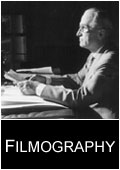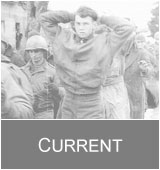For Immediate Release
ACCLAIMED FILMMAKER CHARLES GUGGENHEIM’S FINAL WORK, BERGA: SOLDIERS OF ANOTHER WAR, PRESENTED NATIONALLY BY THIRTEEN/WNET NEW YORK, PREMIERES WEDNESDAY, MAY 28TH ON PBS
American GIs Captured During WW II Battle of the Bulge "Classified" as Jewish by German Captors, Sent to Slave Labor Camp and Subjected to Nazi Holocaust Atrocities
"World War II. My company… I can remember their faces just like yesterday. They went overseas and I didn't, and some of them didn't come back. I've been thinking about it for 50 years, wondering why it didn't happen to me. That's why I had to tell this story." Charles Guggenheim, filmmaker
"The older fellows who had families, survived. The 18-, 19-year-old boys went quickly. I knew I had a family at home. I wanted to live. I just wanted to live." Milton Stolon, Berga survivor
BERGA: SOLDIERS OF ANOTHER WAR, a documentary film revealing Nazi Holocaust atrocities inflicted on 350 American POWs "classified" as Jewish, will be presented nationally by Thirteen/WNET New York on Wednesday, May 28th at 8 p.m. on PBS (check local listings). The film is the final work in the long and distinguished career of the late documentary filmmaker Charles Guggenheim. The four-time Academy Award-winner wrote and directed the film, and because of his personal connection to the story, also narrated in the first person for the first and only time in his career. The film is a production of Guggenheim Productions in Washington, DC.
Thousands of American GIs, including soldiers in Guggenheim’s 106th Infantry Division, were captured by the Nazis during the Battle of the Bulge. Those "identified" as being Jewish–along with fellow GIs who "looked Jewish" or had "Jewish sounding" last names–were selected to fulfill a quota and shipped off to a satellite of the notorious concentration camp at Buchenwald, where they suffered harrowing atrocities as slave laborers. Guggenheim, who had remained stateside with a debilitating infection during the final months of the war carried with him a personal and moral obligation for more than 50 years to tell this untold story for his comrades who did not return, and for those who have lived with the horror of their experience. While completing the film, Guggenheim faced a heroic battle of his own with terminal cancer. He died six weeks after the film was finished.
BERGA: SOLDIERS OF ANOTHER WAR sheds light on a little known fact of World War II: imprisoned American GIs were forced to work alongside slave laborers from Nazi concentration camps. The film, shot entirely in black and white, tells the story through on-camera testimony by survivors and eyewitnesses, archival photographs and film, and re-enactment footage. Many scenes are recreated at original historic locations using young East German locals portraying the American soldiers. The recreations capture the inhuman boxcar transport, slave laborers tunneling through quartz rock, brutal Nazi guards, austere prison conditions, abandoned corpses, makeshift burials in bleak and snowy fields and churchyards, the massive, forced slave labor march of prisoners away from advancing Allies, and then finally the GIs' liberation.
Uncovering the Story
After the war, Guggenheim tried to locate a friend from the 106th Division, but discovered he had died in captivity in a German salt mine. The salt mine turned out to be the slave labor camp at Berga, a small town in East Germany, which the filmmaker confirmed in War Crimes Trial documents located at the National Archives in Washington, DC.
"The idea of this happening, the suggestion of an American soldier persecuted for being Jewish or looking Jewish or otherwise undesirable, never left my mind," said Guggenheim.
After two-and-a-half years of extensive research, Guggenheim found 124 survivors and witnesses. Forty agreed to be interviewed. Many revealed that they had repressed their memories for over 50 years and never talked about their imprisonment, not even to spouses and family members.
Slave Labor at Berga
In December 1944, thousands of American soldiers captured during the Battle of the Bulge were transported to Stalag 9B, a prisoner of war camp northwest of Frankfurt, Germany. A military order was issued that all Jewish soldiers identify themselves. After the Americans refused to comply, Nazi guards selected GI’s they "identified" as Jewish, thought "looked Jewish," had "Jewish-sounding" last names or whom they classified as undesirables. Fewer than a third of the American soldiers selected were, in fact, Jewish.
Packed into railway boxcars with no food, water or toilets, they were transported further into the German countryside. Five days later they arrived at Berga, a satellite of the concentration camp at Buchenwald.
The Americans were put to work alongside European concentration camp prisoners and forced to dig tunnels into rock cliffs that together would form an underground military factory. They were ridiculed, intimidated, beaten, denied heat, given insufficient water, and fed substandard provisions. Many died of injuries, malnutrition, disease, and exhaustion. Several were fatally shot by guards for no apparent reason. Some went mad.
End of the Nightmare – Liberation
By April 1945, as the Allies advanced, the S.S. ordered the evacuation of the camp. Surviving prisoners were marched through rain, snow, and bitter cold on a 150-mile procession of death. Those unable to keep up were abandoned or shot, and those who died were buried in roadside graves or Christian church cemeteries.
The nightmare finally ended on April 23, 1945, when advancing American units came upon and liberated the surviving prisoners. The war in Europe was over five weeks later.
Production Credits
Charles Guggenheim received 12 Academy Award nominations and won 4 Oscars for his films Nine From Little Rock, Robert Kennedy Remembered, The Johnstown Flood, and A Time for Justice. He also won the George Foster Peabody Award.
BERGA: SOLDIERS OF ANOTHER WAR is written, directed and narrated by Charles Guggenheim and produced by Grace Guggenheim. Director of photography is Erich Roland. The editor is Anny Lowery Meza. The original score is composed by Michael Bacon. The sound designer is Skip SoRelle.
The film is funded by the Ilma F. Kern Foundation, Dr. & Mrs. William H. Danforth, Myer Feldman, Milton H. Latter Educational & Charitable Foundation, Park Foundation and The Norman & Rosita Winston Foundation.
Thirteen/WNET New York is one of the key program providers for public television, bringing such acclaimed series as Nature, Great Performances, American Masters, Charlie Rose, Religion & Ethics NewsWeekly, Stage on Screen, EGG the arts show, and Cyberchase–as well as the work of Bill Moyers–to audiences nationwide. As the flagship public broadcaster in the New York, New Jersey and Connecticut metro area, Thirteen reaches millions of viewers each week, airing the best of American public television along with its own local productions such as The Ethnic Heritage Specials, The New York Walking Tours, New York Voices, Reel New York, and its MetroArts/Thirteen cable arts programming. With educational and community outreach projects that extend the impact of its television productions, Thirteen takes television "out of the box." And as broadcast and digital media converge, Thirteen is blazing trails in the creation of web sites, enhanced television, CD-ROMs, DVD-ROMs, educational software, and other cutting-edge media products. More information about Thirteen can be found at: www.thirteen.org.
Press Contacts
Tim Fisher / Lori Lupinski / Kellie Specter
Fisher Company WNET/Thirteen
917-674-6164 212-560-3009
tf@fishercompany.net specter@thirteen.org













